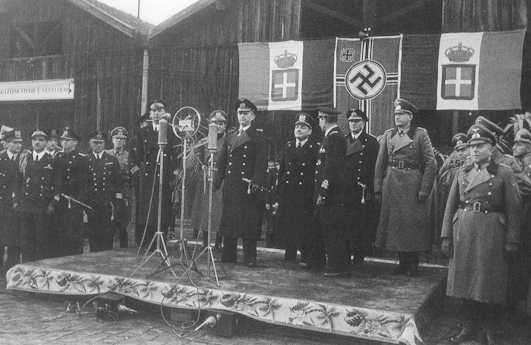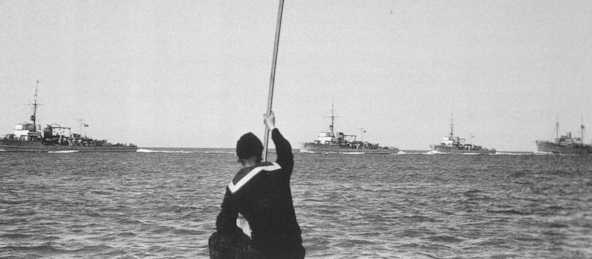Betasom was officially instituted on September 1st, 1940. Organizationally, it reported to two distinct commands: MARICOSOM (Marina, Comando, Sommergibili, or Navy Command Submarines) controlled personnel and technical and administrative functions, while SUPERMARINA controlled operations. MARICOSOM was created in 1939 following the reorganization of the “Comando Divisione Sommergibili” and was headquartered at the Ministry of the Navy, in a beautiful palace on the Tiber in Rome. The fact that this submarine base would operationally report directly to SUPERMARINA was an exception to the established practice and had been dictated by several factors. First, the size of the base (over 30 vessels) made it unusually large; second, the commanding officer was very senior in rank (a rear-admiral), and lastly, the base would be integrated with the existing German naval command structure.

Admiral Karl Dönitz visiting the Italian base in Bordeaux
In fact, to allow for a successful integration of the Italian forces with Admiral Donitz’s U-Boats, the Italian command issued the following directives: “For the coordinated deployment of submarines in war operations in the Atlantic, the group will receive directives from Admiral Donitz, Commander U-Boat Force”. The decision to integrate the Italian forces with the German ones had both tactical and organizational advantages. Tactically, the Germans did not have the required number of boats to properly impede British commercial traffic on a continuous basis; the Italian submarines would assist in providing this numerical advantage. Operationally, it would have been dangerous if the two forces had operated independently of each other, creating the real peril of dramatically increasing the possibility of losses due to friendly fire. After all, the Germans were not the only submarines operating in the Atlantic; British boats were always lurking along the coastline of occupied France.
Nevertheless, although officially reporting to the B.d.U., the German submarine command, the Italian base had a large degree of independence and the right to preserve Italian interests. Since the inception of the base, talented officers from both sides contributed to establishing a true spirit of comradeship. The first German liaison officer was Franz Hans Rosing, who was later replaced by Franz Becker. The Italian liaison officer to B.d.U. was Lieutenant Commander Fausto Sestini, who served for the duration of the conflict. The German command for the Atlantic coast was in Royan, a small city opposite La Pallice at the estuary of the Gironde, and it was later transferred to Nantes, much further north. The integration of the Italian forces called for the utilization of the existing German defenses, and the establishment of new ones. The port of Bordeaux and the shipyards were under the control of the Maritime Defenses of Guascony [Aquitaine] with headquarters in Royan.
The naval forces reported to the Kriegsmarine headquarters in Paris and were organized under the 4th Division and commanded by Kapitän zur See Lautenschlager who, in 1944, he was replaced by Kapitän zur See John. The Paris-based command was under Admiral Kranche, while the Maritime Defense forces were the responsibility of Vice-Admiral (Vizeadmiral ) Breuning. This high command of the Kriesgmarine was originally called Oberbefehlshaber des Admirals West, but after the 22nd of June 1940, it was renamed Oberbefehlshaber des Admirals Frankreich. This command was principally responsible for personnel and provisioning. The commanding officer was Admiral Karl-Georg Schuster until the end of February 1941, later replaced by Admiral Otto Schultze until August 1942, and then Admiral Wilhelm Marschall. Admiral Karl-Georg Schuster was the officer responsible for the first survey of former French installations along the Atlantic Coast and it is know that he visited the facilities later occupied by the Regia Marina.

Some of the minesweepers of the German 8th Flotilla
The 4th Division included the 8th Flotilla, organized in several groups. This flotilla was equipped with about 15 minesweepers of the M35, M39 and M40 type. They ranged from 755 to 908 tons in displacement and were armed with two 105 mm guns and antiaircraft machine guns. The 8th Flotilla was commanded by Kapitäleutnant Kamptz and was headquartered in Royan, but the vessels were distributed over several locations, and more precisely Royan, Pauillac, and La Pallice. According to Francis Sallaberry, the well-known Bordeaux-based author, there was also the 28th flotilla based in Pauillac and commanded by Korvettenkapitän Bidingmaier. This unit was also equipped with 15 minesweepers, but all of the M40 type. Naval defenses also included the very unusual 2nd Flotilla “Sperrbrecher”, often mentioned in the Italian documentation. These “obstruction breakers” were under the command of Kapitäleutnant Körner and based in Royan. The odd-looking fleet included former German, Norwegian, and French cargo ships ranging from a small one of only 480 tons, to the 7,090 tons former “Saurland”. These ships had been militarized with the installation of 105 mm naval guns, and 37 mm and 20 mm antiaircraft machine guns. Their task was to meet the submarines out at sea and escort them to safer waters by opening a path through the insidious magnetic mines launched by the Royal Air Force or deposited by the Royal Navy. They also provided escort for blockade-runners entering or leaving port.
The defense of the waterways around Bordeaux was the responsibility of the 4th flotilla, a group of about 28 smaller patrol and service vessels no larger than 500 tons and mostly imported from Germany. These vessels were armed with small machine guns and an 88 mm gun. The dockyards and the arsenal, as already mentioned, were the responsibility of the Kriegsmarine. The first commanding officer was Kapitäleutnant Siegfried Punt, who held the assignment until November 1942 and was later replaced by Kapitäleutnant Heinrich Wagner, who commanded until January 1944. During the period between January and August 1944, the commanding officer was Kapitäleutnant Carl Weber, an engineer.
The defense of the city of Bordeaux was instead the responsibility of the Wehrmacht. The area was organizationally under the 1st Army, and the local commander was Colonel Seiz, the military commander of Bordeaux, later replaced (1942) by General Knoerger. The port itself, including the submarine bases, remained under the Krigsmarine, while the airport of Merignac remained under the Luftwaffe. The Wehrmatcht built bunkers throughout the area, including three in Gradignan (Château Brandier), town later to become the base of the Italian command.
The defenses around the base included 88 mm and 75 mm guns and 20 mm antiaircraft machine guns, along with a number of searchlights.